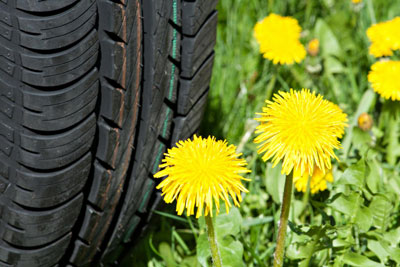| Apr 28, 2015 |
A biotechnological production of rubber comes closer
|
|
(Nanowerk News) Dandelions deliver a desirable product: rubber. This is why the robust and undemanding plant has become the focus of attention of the rubber-producing industry. But how is rubber, contained in the plant's white milky fluid, actually formed? A team of scientists has now identified proteins, which play a key role in the production of rubber in the plant. Thus a biotechnological production of rubber comes closer.
|
 |
| Dandelions produce rubber. Scientists now identified a key-protein, which controls the rubber production. This makes a biotechnological production of natural rubber come closer. (Image: Uli Benz, TU München)
|
|
The milky fluid containing the rubber is produced in special cells in the dandelion. Responsible for the formation - the biosynthesis - of the rubber is a protein complex located on the surface of so-called rubber particles. These globular particles are filled with polyisoprene, the main component of rubber, and are surrounded by a protective coating.
|
|
As the researchers at Münster University, the Münster branch of the Fraunhofer Institute for Molecular Biology and Applied Ecology IME, the Technische Universität München (TUM) and TRM Ltd. (York, UK) demonstrated, using the example of Russian dandelion, Taraxacum kok-saghyz, there is one special protein (a so-called rubber transferase activator) which plays a key role. If the formation of the protein is prevented - in other words, if it doesn't exist in the plant - then no rubber is formed.
|
|
The scientists assume that the protein is necessary for the formation of the rubber-producing protein complex. Their results have been published in the current online issue of the journal Nature Plants. A second study, which was carried out with substantial input from researchers from IME and Münster University, identifies a further important protein which plays a key role in the formation of the long polyisoprene chains. These polymers give the rubber its typical properties - its elasticity and resilience.
|
|
A long-standing collaboration exists between the research groups in Munich and Münster. "First we have contributed by labeling studies using stable isotopes to investigate the metabolic pathways for latex production," says Professor Wolfgang Eisenreich, biochemist at TU München. As part of the now published work the team in Munich characterized the polyisoprene produced by the plant using NMR spectroscopic measurements.
|
|
Effective cooperation between basic and applied research
|
|
"Dandelions have become well-known recently in particular as a result of applied research," explains head of research Dr. Christian Schulze Gronover (IME, Münster branch). "Now we are pleased to have some news again from the field of basic research: we have been able to identify no fewer than two key components of rubber biosynthesis."
|
|
So far it has not been possible to manufacture natural rubber biotechnologically. But the identification of key components in rubber synthesis has brought this possibility a step closer, the researchers say. Dandelion plants that produce no rubber could be used in future laboratory experiments in order to examine the role of rubber in the plants. According to one idea under discussion, for example, it provides protection against pathogenic agents.
|
|
Dirk Prüfer, Professor of the Biotechnology of Plants at Münster University and head of the Functional and Applied Genomics department at the IME in Münster, points out: "We achieved these research results only through effective collaboration between IME and Münster University - in other words, through the intelligent linking of applications-oriented and basic research. We hope to expand this successful model further."
|
|
Publications
|
|
Nature Plants ("A rubber transferase activator is necessary for natural rubber biosynthesis in dandelion")
|
|
The Plant Journal ("Identification of a Taraxacum brevicorniculatum rubber elongation factor protein that is localized on rubber particles and promotes rubber biosynthesis")
|

